The world is on the cusp of a technological revolution driven by innovation and science. As we approach 2025, it’s crucial to identify the emerging technologies that will reshape industries and everyday life.
The pace of technological advancement has accelerated, creating opportunities and challenges for businesses, governments, and individuals. Artificial intelligence and research in various fields are driving these trends, with climate change being a significant factor.
Understanding these emerging trends is vital for professionals, investors, and policymakers to prepare for the rapidly evolving landscape.
- The Acceleration of Technological Innovation
- How to Evaluate the Potential of Emerging Technologies
- Advanced Artificial Intelligence and Language Models
- Quantum Computing: From Theory to Practical Applications
- Space Technology and the New Space Age
- Sustainable Energy Solutions
- Advanced Robotics and Automation
- Biotechnology and Genetic Engineering
- Climate Technology and Environmental Solutions
- Advanced Healthcare Technologies
- Extended Reality (XR): Beyond Current Capabilities
- The Impact of Emerging Technologies on Society
- Economic Implications of Technological Disruption
- India’s Position in the Global Technology Landscape
- How to Prepare for the Technology of Tomorrow
- Conclusion: Navigating the Future of Technology
- FAQ
- What are the top emerging technologies to watch in 2025?
- How is Artificial Intelligence expected to evolve in the coming years?
- What is the significance of Quantum Computing, and how will it impact industries?
- How will Space Technology shape the future of humanity?
- What are the key indicators of technological breakthroughs, and how can they be evaluated?
- How can individuals and organizations prepare for the technology of tomorrow?
Key Takeaways
- The top 10 emerging technologies expected to have a significant impact in 2025.
- How these technologies will reshape various industries and aspects of life.
- The role of artificial intelligence in driving these technological trends.
- The importance of understanding these trends for professionals and policymakers.
- The potential of these technologies to address global challenges like climate change.
The Acceleration of Technological Innovation
As we approach 2025, the pace of technological change is intensifying. The convergence of multiple technological breakthroughs is expected to create a perfect storm of innovation across industries.
The exponential growth in computing power, data processing capabilities, and connectivity has laid an unprecedented foundation for technological advancement. Historical patterns suggest we’re entering a period of accelerated change, with the time between major innovations shrinking dramatically compared to previous eras.
Why 2025 Is a Pivotal Year for Technology
Several factors contribute to the significance of 2025:
- The rise of collaborative innovation ecosystems has accelerated technological development.
- Key technologies have reached critical inflection points, moving from experimental phases to practical implementation.
- The democratization of technology development tools has enabled a diverse range of innovators to contribute.
These factors collectively create an environment where innovation can thrive, leading to significant advancements in various systems and products.
How Emerging Technologies Are Reshaping Industries
Industries from healthcare to manufacturing are being fundamentally reshaped by emerging technologies. This transformation creates both opportunities for growth and challenges for adaptation. The impact of these technologies is evident in the way they improve efficiency, reduce costs, and open new avenues for innovation.
As we look to the future, understanding the dynamics of technological innovation will be crucial for businesses and individuals alike. By staying informed about the latest developments and trends, we can better navigate the changing landscape and capitalize on the opportunities that arise.
How to Evaluate the Potential of Emerging Technologies

With the pace of technological innovation accelerating, understanding how to evaluate emerging technologies is more important than ever. As new technologies emerge, they bring with them both opportunities and challenges. To navigate this complex landscape, it’s essential to have a systematic framework for assessment.
Key Indicators of Technological Breakthroughs
Evaluating emerging technologies requires considering several key indicators. These include exponential improvements in performance metrics, significant cost reductions, and the emergence of complementary technologies that enable wider adoption. Research funding patterns often provide early signals about which technologies are gaining momentum, with substantial increases in both public and private investment preceding major breakthroughs.
Patent activity serves as another critical indicator, with surges in patent filings often preceding commercial breakthroughs by 3-5 years. By analyzing these indicators, organizations can develop a sense of which technologies are likely to have a significant impact.
| Indicator | Description | Impact |
|---|---|---|
| Performance Metrics | Exponential improvements in technology performance | High |
| Cost Reductions | Significant decreases in production or implementation costs | Medium-High |
| Complementary Technologies | Emergence of supporting technologies that enhance adoption | High |
| Research Funding | Increases in public and private investment in research | Medium |
| Patent Activity | Surges in patent filings related to the technology | Medium-High |
Balancing Innovation with Practical Implementation
Practical implementation challenges must be balanced against innovative potential, as many promising technologies fail to cross the “valley of death” between laboratory success and commercial viability. Risk assessment frameworks help organizations determine which emerging technologies warrant investment and at what stage of development.
By taking a data-driven approach to evaluating emerging technologies, businesses can make informed decisions about where to allocate resources. This involves considering not just the potential benefits of a technology, but also the potential risks and challenges associated with its implementation.
The most successful technology adopters develop a sense for distinguishing between genuinely transformative innovations and overhyped technologies that may not deliver on their promises. By combining technical expertise with business acumen and a deep understanding of the market landscape, organizations can navigate the complex world of emerging technologies and identify opportunities that are likely to drive future growth.
Advanced Artificial Intelligence and Language Models
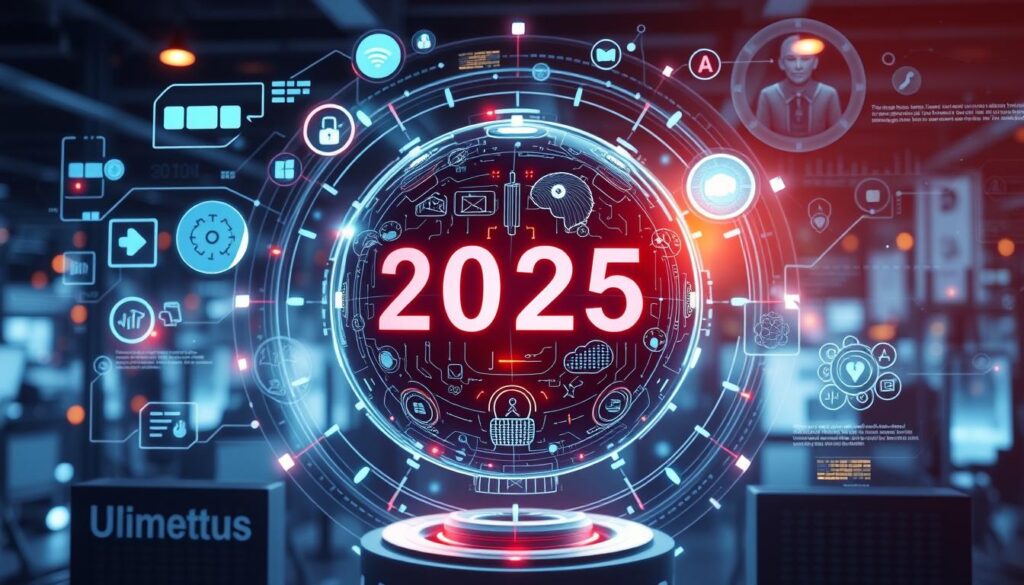
The year 2025 promises to be a landmark year for technology, with AI and language models leading the charge in innovation. As we approach this milestone, it’s crucial to understand the advancements that are reshaping the technological landscape.
Beyond Current AI Capabilities
Advanced AI systems in 2025 will move beyond pattern recognition to demonstrate more sophisticated reasoning capabilities, contextual understanding, and creative problem-solving abilities. This leap forward will be driven by enhancements in language models, enabling more comprehensive and nuanced interactions between humans and machines.
The next-generation language models will feature enhanced multimodal capabilities, integrating text, vision, audio, and potentially other sensory inputs to create more comprehensive understanding systems.
Ethical Considerations and Regulatory Frameworks
As AI continues to evolve, ethical considerations surrounding its deployment will become increasingly prominent. Issues of bias, transparency, accountability, and the potential for autonomous decision-making will be at the forefront. Regulatory frameworks for AI governance will mature globally, with international standards emerging for high-risk applications and mandatory impact assessments becoming commonplace.
Potential Applications in Business and Society
The role of AI in automating complex cognitive tasks will expand dramatically, with applications in scientific research, creative industries, and professional services. Business applications will extend beyond current automation use cases to include strategic decision-making support, enhanced product development, and entirely new business models built around AI capabilities. The integration of advanced language models into everyday technologies will transform how people interact with digital systems, making technology more accessible to non-technical users.
By 2025, we can expect to see significant advancements in how AI and language models are integrated into various aspects of business and society, leading to more efficient and innovative solutions.
Quantum Computing: From Theory to Practical Applications

In 2025, quantum computing will start to transition from theory to practical applications, marking a significant milestone in the technology landscape. Recent advancements in quantum computing have been substantial, with several breakthroughs that are poised to revolutionize various industries.
Recent Breakthroughs in Quantum Technology
Significant progress has been made in error correction, qubit stability, and quantum architecture design. These breakthroughs have accelerated the timeline for achieving quantum advantage in specific computational domains. As a result, quantum computing is becoming increasingly viable for practical applications.
The Massachusetts Institute of Technology and other leading research institutions have been at the forefront of these advancements, contributing to the rapid evolution of quantum technology.
Industries Poised for Quantum Disruption
Several industries are expected to be early beneficiaries of quantum computing capabilities, including pharmaceuticals, materials science, logistics, and financial services. Quantum algorithms will enable these industries to solve complex problems that are currently unsolvable or require significant computational resources.
The potential applications of quantum computing in these industries are vast, ranging from optimizing complex systems to simulating molecular interactions for drug discovery.
The Quantum Computing Ecosystem in India
India’s quantum computing ecosystem is rapidly developing, driven by significant government investment through the National Mission on Quantum Technologies and Applications (NM-QTA). Leading Indian research institutions, such as the Indian Institute of Science (IISc) and the Tata Institute of Fundamental Research, are establishing quantum computing research centers.
Collaborations between Indian institutions and global quantum leaders like IBM, Google, and the Massachusetts Institute of Technology are accelerating knowledge transfer and capability development in the field of quantum research.
As quantum computing continues to evolve, it is expected to have a profound impact on various sectors, driving innovation and transforming the way complex problems are addressed.
Space Technology and the New Space Age

The dawn of a new space age is upon us, marked by unprecedented advancements in space technology. This era is characterized by increased commercialization, reduced launch costs, and expanded access to space-based resources and capabilities.
Commercial Space Exploration Ventures
Commercial space exploration ventures are transitioning from demonstration missions to sustainable business models. By 2025, regular orbital, lunar, and potentially Mars-bound missions are expected to become operational, marking a significant shift in space exploration.
Satellite Technology and Global Connectivity
Advancements in satellite technology, particularly in miniaturization, propulsion, and on-board processing, are enabling new applications in Earth observation, communications, and space-based research. Global connectivity through satellite constellations will reach new levels, bringing high-speed internet access to previously underserved regions around the world.
Space Resources Utilization
Space resources utilization is moving from concept to early demonstration. Missions are testing technologies for in-situ resource utilization on the Moon and asteroids, paving the way for a new era of space exploration and development.
The democratization of space access is creating opportunities for more countries, including India, to develop indigenous space age capabilities and participate in the growing space economy. Regulatory frameworks for space activities are evolving to address new challenges, including space traffic management, debris mitigation, and resource extraction rights, ensuring a sustainable future for space technology and the space age that is unfolding.
As technology continues to advance, it is expected that more people will be involved in research and development in the space sector, driving innovation and pushing the boundaries of what is possible.
Sustainable Energy Solutions
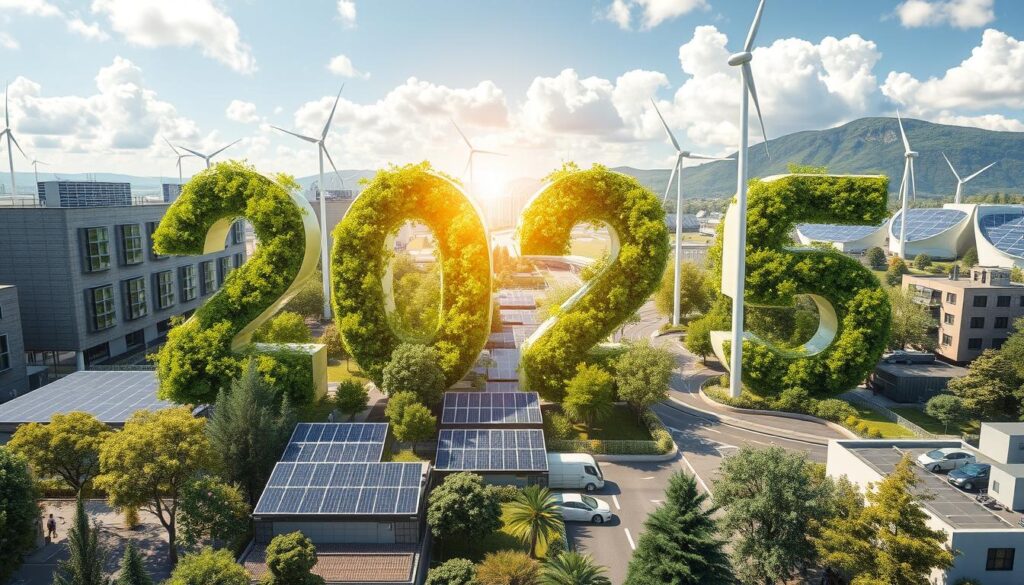
The global energy landscape is on the cusp of a revolution with sustainable energy technologies leading the charge in 2025. As the world grapples with the challenges of climate change and energy security, innovations in renewable energy are poised to play a crucial role in shaping the future.
Next-Generation Solar and Wind Technologies
Next-generation solar technologies, including perovskite cells and tandem solar cells, are expected to achieve commercial viability in 2025. These advancements will significantly improve efficiency-to-cost ratios, making solar energy more competitive against fossil fuels. Wind energy innovations, particularly in offshore and high-altitude wind capture, will expand potential deployment zones and increase energy yield per installation.
Energy Storage Breakthroughs
Energy storage is a critical component of a sustainable energy future, addressing the intermittency challenge of renewable energy sources. Advanced battery chemistries and mechanical storage systems are being developed to provide more efficient and cost-effective solutions. Grid-scale energy storage will become increasingly important as the share of renewable energy in the global energy mix continues to grow.
Nuclear Fusion Progress
Nuclear fusion research is making significant strides, with several private ventures and public research programs demonstrating sustained fusion reactions. While still in the experimental phase, nuclear fusion has the potential to provide a nearly limitless source of clean energy. Nuclear power could become a game-changer in the global energy landscape if these technological challenges are overcome.
The integration of artificial intelligence for energy management will optimize generation, storage, and distribution across increasingly complex and decentralized power systems. These sustainable energy technologies collectively represent critical tools for addressing climate change while meeting growing global energy demands.
Advanced Robotics and Automation
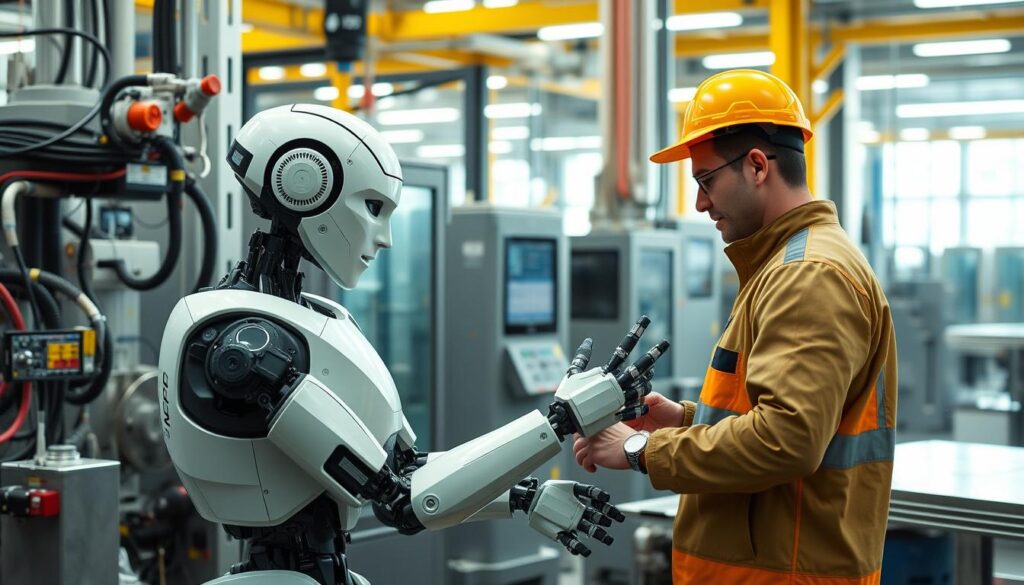
The future of robotics in 2025 and beyond is set to be shaped by innovations in automation and artificial intelligence. As we approach this pivotal year, the field of robotics is on the cusp of a significant transformation, driven by advancements in autonomy, adaptability, and human-like capabilities.
Advancements in Robotics Capabilities
Advanced robotics in 2025 will be characterized by increased autonomy, adaptability, and human-like capabilities, expanding their potential applications across industries and everyday environments. Humanoid robots, in particular, will advance significantly in mobility, dexterity, and interaction capabilities.
These advancements will enable humanoid robots to find applications in healthcare, customer service, and hazardous environments where human-like form factors provide advantages. For instance, robots could assist in surgeries, provide companionship for the elderly, or perform tasks in environments that are dangerous for humans.
Industrial Automation Evolution
Industrial automation will evolve beyond rigid, pre-programmed operations to incorporate adaptive systems that can learn from experience, respond to changing conditions, and work safely alongside human workers. This evolution will be driven by advances in tactile sensing, computer vision, and reinforcement learning, enabling robots to perform increasingly complex manipulation tasks.
Such capabilities will revolutionize manufacturing processes, making them more efficient and flexible. The integration of robots in industries will not only enhance productivity but also improve workplace safety.
Human-Robot Collaboration
Human-robot collaboration paradigms will mature, with intuitive interfaces, natural language communication, and predictive behavior making robots more accessible partners for non-technical users. This will facilitate a seamless interaction between humans and robots, enhancing collaboration and productivity.
As robots become more integrated into workplaces and public spaces, ethical and social considerations around robot deployment will become increasingly important. Ensuring that robots are designed and used in ways that benefit society will be a key challenge and opportunity in 2025.
The democratization of robotics development through more accessible hardware platforms and programming tools will accelerate innovation and customization for specific applications. This trend will open up new possibilities for businesses and individuals to develop and deploy robots tailored to their needs.
Biotechnology and Genetic Engineering

Biotechnology and genetic engineering are on the cusp of a breakthrough in 2025, promising transformative impacts on health and technology. The advancements in these fields are expected to revolutionize various sectors, including healthcare, agriculture, and materials production.
Advances in Gene Editing
The CRISPR gene editing technology is advancing beyond its current capabilities, with improvements in precision, reduced off-target effects, and expanded delivery mechanisms for therapeutic applications. This progress is crucial for treating genetic disorders and will significantly impact the field of health.
Synthetic Biology Applications
Synthetic biology is expanding from laboratory demonstrations to commercial-scale production of novel biomaterials, pharmaceuticals, and sustainable alternatives to petrochemical products. This shift is driven by advancements in technology and science, enabling the creation of new products that benefit people worldwide.
Personalized Medicine
Personalized medicine approaches based on individual genetic profiles are becoming more mainstream. Targeted therapies designed to address specific genetic variations associated with diseases are being developed, marking a significant step forward in healthcare. The integration of research in genetic engineering with artificial intelligence is accelerating discovery processes, enabling more efficient identification of genetic targets and therapeutic approaches.
The future of biotechnology and genetic engineering looks promising, with potential applications in various fields, including the laboratory setting, where new technologies are being developed and tested. As these technologies continue to evolve, they will have a profound impact on society, improving the quality of life for people around the world.
Climate Technology and Environmental Solutions
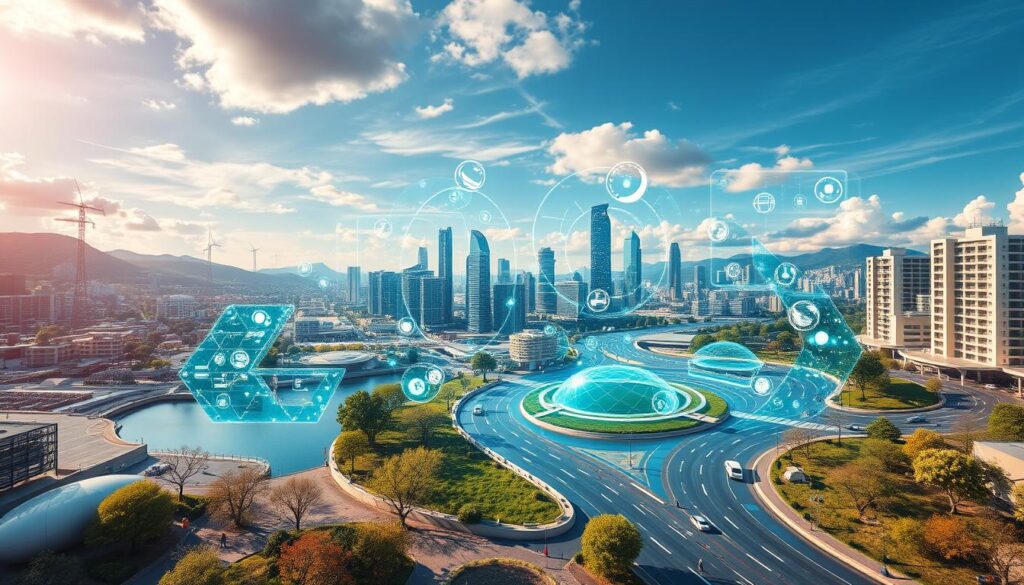
Emerging climate technologies are anticipated to play a crucial role in addressing the pressing issue of climate change by 2025. As the world grapples with the challenges posed by global warming, innovative solutions are being developed to mitigate its impacts.
The year 2025 is expected to witness significant advancements in climate technology, moving beyond experimental stages to scaled solutions that can make a meaningful impact on greenhouse gas concentrations and environmental restoration. These advancements are crucial for reducing the climate change impacts that have been increasingly felt across the globe.
Innovations in Carbon Capture
One of the key areas of focus is carbon capture and sequestration. Innovations in this field are expected to achieve dramatic cost reductions and efficiency improvements, making these technologies economically viable for widespread deployment across industrial sectors. Direct air capture technologies will reach commercial scale, complementing point-source carbon capture and providing pathways to address historical emissions.
Advancements in Climate Modeling
Furthermore, climate modeling and prediction systems will benefit from increased computational power and improved data collection, enabling more accurate forecasting of climate impacts at regional and local scales. This will be crucial for developing targeted strategies to address the effects of climate change.
Sustainable Materials Development
The development of sustainable materials will accelerate, with bio-based alternatives, advanced recycling technologies, and circular design principles becoming mainstream in manufacturing. This shift will not only reduce environmental impacts but also promote a more circular economy.
In addition to these advancements, water management technologies, including advanced filtration, atmospheric water harvesting, and precision irrigation, will address growing water scarcity challenges around the world. The integration of these climate technologies into coherent environmental strategies will be essential for addressing climate change while supporting sustainable development goals.
Research and development will continue to play a vital role in driving these innovations, ensuring that the technologies are not only effective but also scalable and sustainable. As we move towards 2025, it is clear that technology will be at the forefront of our efforts to combat climate change and create a more sustainable world.
Advanced Healthcare Technologies

As we approach 2025, the integration of advanced healthcare technologies is set to revolutionize disease detection, treatment, and management. The healthcare sector is witnessing significant transformations due to technological innovations.
AI-Driven Diagnostics and Treatment
AI-driven diagnostic systems are achieving accuracy levels comparable to or exceeding those of specialist physicians in specific domains. This technology provides consistent access to expertise in underserved regions, enhancing healthcare accessibility. Artificial intelligence is playing a crucial role in improving diagnostic precision.
Remote Healthcare Monitoring Systems
Remote healthcare monitoring is evolving from basic vital sign tracking to comprehensive health assessments through advanced wearables, implantables, and environmental sensors. The integration of these monitoring systems with predictive analytics enables earlier intervention for developing health conditions, potentially preventing acute episodes and hospitalizations. This shift towards proactive healthcare is expected to improve patient outcomes significantly.
Nanomedicine Breakthroughs
Nanomedicine breakthroughs are enabling targeted drug delivery, precise surgical interventions, and novel therapeutic approaches at the cellular level. These advancements are dramatically improving treatment efficacy while reducing side effects. Leading medical centers, including those in New York and other major health hubs, are pioneering the clinical implementation of these technologies.
The collective impact of these advanced healthcare technologies will be to provide more personalized, preventative, and accessible health services for people across different socioeconomic backgrounds. By leveraging technology, the healthcare industry is poised to make significant strides in improving health outcomes.
Extended Reality (XR): Beyond Current Capabilities
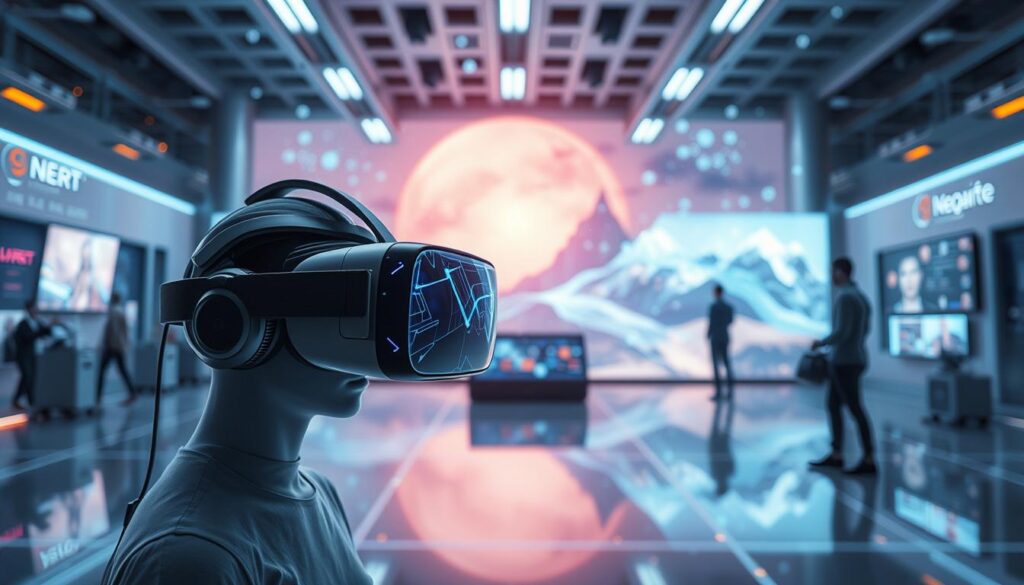
Extended Reality (XR) is set to transcend its current limitations, offering more immersive and practical applications across industries. As we approach 2025, significant advancements in visual fidelity, haptic feedback, and user comfort are expected to drive this transformation.
Metaverse Development
The metaverse is evolving from conceptual frameworks to functional digital environments. These environments will have practical applications in commerce, entertainment, education, and professional collaboration, changing the way people interact with digital information.
AR/VR in Education and Training
AR/VR technologies are being increasingly integrated into educational curricula, providing immersive learning experiences that improve engagement and knowledge retention for students of all ages, including children. This technology is also expanding in professional training, offering cost-effective simulations for skills development.
XR for Remote Collaboration
Remote collaboration through XR is evolving from a novelty to a necessity for many organizations. It enables more natural and effective interaction between geographically distributed teams, saving time and enhancing productivity. As XR technologies become more seamlessly integrated into everyday activities, they will fundamentally change the world of work.
Advances in hardware miniaturization, battery technology, and wireless connectivity are making XR devices more comfortable and practical for extended use periods. This will lead to a significant shift in how people work and interact with technology, blurring the boundaries between physical and digital worlds.
The Impact of Emerging Technologies on Society
As we approach 2025, the influence of emerging technologies on societal norms becomes increasingly evident. Emerging technologies are not just transforming industries; they are reshaping the very fabric of our society.
Addressing Digital Divide and Accessibility
The digital divide remains a critical challenge as technological advancements continue to accelerate. To prevent exacerbating existing inequalities, it is crucial to adopt inclusive design and deployment strategies. Accessibility features are becoming more sophisticated, making digital tools more usable for people with disabilities and the elderly.
A key aspect of addressing the digital divide is ensuring that vulnerable populations, including those with limited technical literacy or economic resources, receive targeted support. This will enable them to benefit from technological advancements rather than being marginalized.
| Technological Advancement | Impact on Society | Accessibility Measures |
|---|---|---|
| Advanced AI and Automation | Changes in job market dynamics | Training programs for new skills |
| Extended Reality (XR) | Enhanced educational experiences | Affordable XR devices for all |
| Biotechnology | Advancements in healthcare | Public health initiatives and awareness |
Ethical Considerations for Technological Advancement
As technology continues to evolve, ethical considerations are moving from academic discussions to practical frameworks guiding technology development and deployment. There is an increased emphasis on transparency, accountability, and human-centered design.
The impact of technology on children requires special attention, balancing concerns about screen time, privacy, and developmental effects against potential benefits in learning and connectivity. Ensuring educational equity is crucial in this context.
Societal resilience will depend on developing adaptive governance models that can respond to rapidly evolving technological capabilities while upholding core human values and rights.
Economic Implications of Technological Disruption
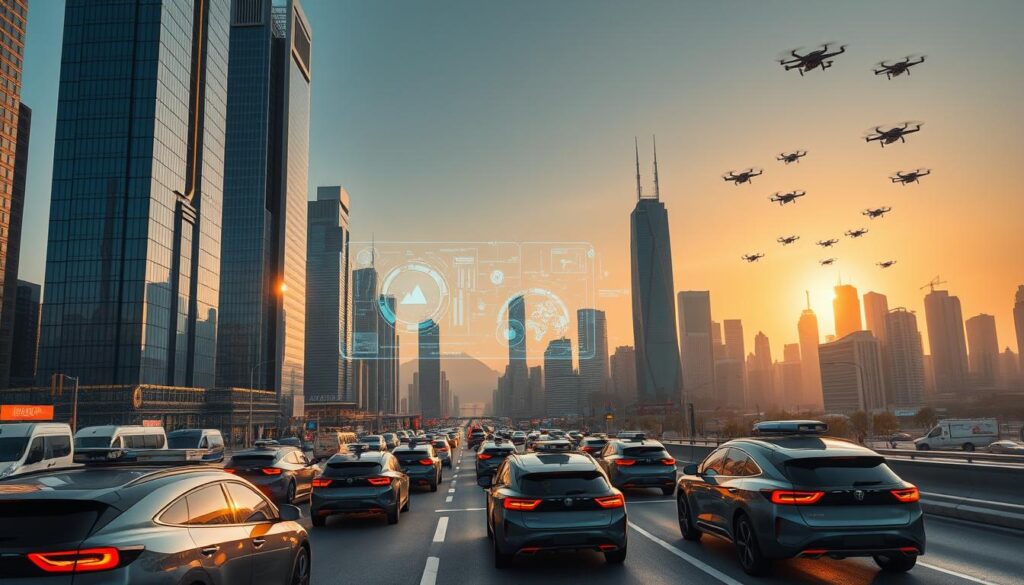
The year 2025 is poised to witness a seismic shift in the economic fabric due to the disruptive potential of cutting-edge technology. As emerging technologies continue to evolve, they are expected to significantly impact the global economy, transforming industries and redefining the nature of work.
At the heart of this transformation is the job market, which is undergoing a significant shift. Automation and AI are not only affecting routine manual tasks but are increasingly influencing complex cognitive work. This necessitates that people adapt their skills and career paths to remain relevant in a rapidly changing job landscape.
Job Market Transformation
The acceleration of technology adoption will lead to a substantial transformation in the job market. As AI and automation become more prevalent, people will need to engage in continuous learning and skill development to remain employable. The half-life of technical skills is shortening, making it imperative for workers to update their skills regularly to stay relevant.
New job categories are emerging around the development, implementation, and management of emerging technologies. While some jobs may be displaced, the creation of new opportunities is expected to offset these losses over time. As the job market evolves, people get the chance to explore new career paths that were previously unimaginable.
New Business Models and Opportunities
The advent of new technology-enabled business models is creating fresh opportunities for entrepreneurial ventures. Distributed systems, direct-to-consumer channels, and technological platforms are challenging incumbent companies and fostering innovation. The gig economy is also evolving, with more sophisticated matching algorithms and specialized platforms changing how people get work and how organizations access talent.
As the economic landscape continues to evolve, it is crucial for societies to manage this transition effectively. By investing in education, social safety nets, and regulatory frameworks, societies can mitigate the adverse effects of technological disruption and ensure that the benefits are equitably distributed, improving the lives of individuals over time.
India’s Position in the Global Technology Landscape
As we approach 2025, India’s role in the global technology landscape is poised for significant transformation. The country is leveraging its large talent pool, growing domestic market, and strategic government initiatives to play an increasingly significant role.
Indian Tech Startups and Innovation Hubs
Indian tech startups are gaining international recognition and attracting substantial investment, with several unicorns emerging in sectors including fintech, edtech, healthtech, and enterprise software. Innovation hubs in Bangalore, Hyderabad, Pune, and the National Capital Region are developing distinct specializations while fostering cross-disciplinary collaboration and knowledge exchange.
The rise of India-specific technology solutions addressing unique local challenges is creating models that can be adapted for similar contexts around the world. For instance, solutions developed for India’s complex financial inclusion challenges are now being explored for adoption in other emerging markets.
Government Initiatives and Policy Framework
Government initiatives including Digital India, Startup India, and the National Education Policy are creating a more supportive ecosystem for technology development and entrepreneurship. India’s policy framework is evolving to balance innovation promotion with considerations of data sovereignty, privacy protection, and equitable access to technology benefits.
International partnerships between Indian institutions and global technology centers in places like New York, Silicon Valley, and Tel Aviv are accelerating knowledge transfer and market access. These collaborations are not only enhancing India’s global standing but also contributing to the global technology landscape.
As India continues to rise in the global technology landscape, it is likely to have a profound impact on the world at large. The country’s growing influence is expected to drive further innovation and technological advancements, shaping the future of technology around the world.
“India is on the cusp of a technology revolution that will have far-reaching implications for the world.”
How to Prepare for the Technology of Tomorrow
Preparing for the technology of tomorrow demands a proactive stance, incorporating skills development, investment decisions, and organizational adaptation. As technological innovation accelerates, the need for a forward-thinking approach has become increasingly evident.
Skills Development for Future Technologies
Skills development should focus on building foundational capabilities that remain relevant despite rapid technological change. This includes critical thinking, creative problem-solving, and adaptive learning. Technical education for both adults and children needs to evolve beyond teaching specific tools to emphasizing underlying principles and the ability to quickly master new technologies as they emerge.
Parents and educators face particular challenges in preparing children for a technological future that may look very different from the present. This requires balanced approaches that embrace beneficial technologies while teaching critical digital literacy. Moreover, special consideration should be given to how vulnerable people, including the elderly and those with limited resources, can be supported through technological transitions.
Investment Opportunities in Emerging Tech
Investment opportunities in emerging technologies will require more sophisticated evaluation frameworks. These frameworks should consider not only technical potential but also regulatory landscapes, ethical implications, and societal acceptance. Organizations should develop systematic approaches to technology horizon scanning, experimentation, and implementation to avoid being blindsided by disruptive innovations.
As we move forward, it’s essential to recognize that the time to begin preparation is now. The accelerating pace of technological change leaves less room for reactive approaches. By focusing on skills development and strategic investments, we can harness the potential of emerging technologies to create a better future for people around the world.
Conclusion: Navigating the Future of Technology
As we navigate the complexities of technological evolution, 2025 emerges as a critical juncture that will determine the trajectory of human progress. The convergence of multiple technological breakthroughs in 2025 will create unprecedented opportunities and challenges for humanity, requiring thoughtful navigation of complex trade-offs.
The pace of technological change is accelerating, compressing the time available for adaptation and necessitating more proactive approaches to technology governance and skills development. Emerging technologies offer potential solutions to many of humanity’s most pressing challenges, from climate change to healthcare access, but also introduce new risks that must be carefully managed.
The most successful individuals, organizations, and societies will be those that develop the capacity to continuously learn, adapt, and evolve alongside technological advancement. It is crucial to protect vulnerable people, especially children, from potential technological harms while ensuring they benefit from technological opportunities, which will require special attention and dedicated resources.
The future relationship between homo sapiens and the technologies we create will continue to evolve, potentially redefining what it means to be human in the age of artificial intelligence and genetic engineering. Navigating this future successfully will require not just technical expertise but wisdom about how to direct technological power toward enhancing human flourishing and protecting the natural world.
The role of scientists, engineers, policymakers, and citizens in shaping this technological future has never been more important or more challenging. As we move forward, it is essential to harness the potential of emerging technologies while mitigating their risks, ensuring a future where technology serves humanity’s best interests.
FAQ
What are the top emerging technologies to watch in 2025?
The top emerging technologies to watch in 2025 include Advanced Artificial Intelligence, Quantum Computing, Space Technology, and Biotechnology, among others. These technologies are expected to drive significant innovation and disruption across various industries.
How is Artificial Intelligence expected to evolve in the coming years?
Artificial Intelligence is expected to become increasingly sophisticated, with advancements in Language Models and AI-driven Diagnostics. This will enable businesses and organizations to automate complex tasks, improve decision-making, and enhance customer experiences.
What is the significance of Quantum Computing, and how will it impact industries?
Quantum Computing has the potential to revolutionize industries such as Healthcare, Finance, and Cybersecurity by enabling faster and more secure processing of complex data. Recent breakthroughs in Quantum Technology are expected to drive significant advancements in these fields.
How will Space Technology shape the future of humanity?
Space Technology is expected to play a critical role in shaping the future of humanity, with advancements in Commercial Space Exploration, Satellite Technology, and Space Resources Utilization. This will enable greater access to space, improved global connectivity, and new opportunities for resource utilization.
What are the key indicators of technological breakthroughs, and how can they be evaluated?
Key indicators of technological breakthroughs include significant advancements in Research and Development, Innovation, and Practical Implementation. Evaluating these indicators requires a deep understanding of the underlying Science and Technology, as well as the potential impact on industries and society.
How can individuals and organizations prepare for the technology of tomorrow?
To prepare for the technology of tomorrow, individuals and organizations must focus on Skills Development and Investment Opportunities in emerging technologies. This includes staying up-to-date with the latest trends and advancements, as well as being open to new ideas and innovations.

